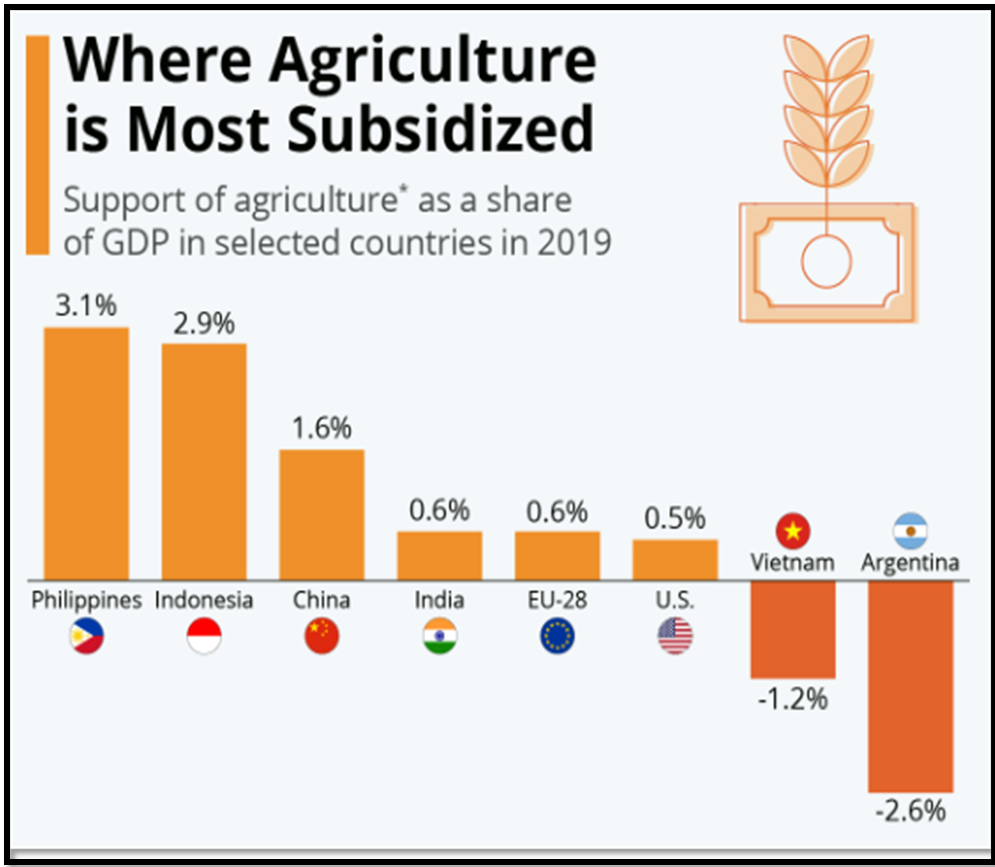GOVERNMENT AGRICULTURAL SUBSIDIES OVERVIEW
Syllabus:
- GS 3: Agriculture
- GS 3: Issues related to subsidies
Why in the News?
Agri-economist Ashok Gulati warns that India might need to import 80-100 lakh tonnes of pulses by 2030 due to continued heavy subsidies on paddy under current policies.
Source: Statista
Introduction
- Agri-economist Ashok Gulati highlighted the need for incentives to grow pulses, which are less water-intensive and more nutritious than paddy.
- He urged for a “crop-neutral incentive structure” to boost pulse and oilseed cultivation, aiming for self-sufficiency in India.
| Farmers: Key developments and Future Directions
Government Support and Investments
Technological and Policy Innovations
Market and Export Growth
Future Directions
|
What are Agriculture subsidies?
- Agriculture subsidies are financial aids provided by governments to support farmers and boost agricultural productivity.
- These subsidies aim to reduce the cost of farming inputs, stabilize food prices, and ensure food security.
Need for Introduction of Agriculture Subsidies in India
- Article 48 of the Indian Constitution: Mandates the modernization of agricultural organizations as a state responsibility.
- FAO Statistic: 70% of rural Indian households rely predominantly on agriculture for their livelihood.
- Enhancing Productivity: Increase crop yields and efficiency through affordable inputs.
- Supporting Farmers: Provide financial relief and reduce operational costs.
- Ensuring Food Security: Stabilize food supply and prices for consumers.
- Encouraging Sustainable Practices: Promote eco-friendly farming techniques and technologies.
- Boosting Rural Economy: Strengthen the agricultural sector’s economic contribution and employment.
Types of Agriculture Subsidies in India
Crop Insurance Subsidies
- Crop insurance subsidies are financial aids provided to farmers to help them manage the risks associated with crop production, cover losses caused by natural disasters, pests, diseases etc.
Government Schemes
- Pradhan Mantri Fasal Bima Yojana (PMFBY): Offers comprehensive insurance for losses due to natural calamities, pests, and diseases, provide compensating for yield losses. It covers all food and cash crops.
- Weather-Based Crop Insurance Scheme (WBCIS): Focuses on weather parameters such as rainfall and temperature which impact crop yields, provides compensation based on deviations from normal weather conditions affecting crops.
Irrigation Subsidies
- Irrigation subsidies are financial aids aimed at supporting the development of irrigation infrastructure, improving water use efficiency.
Government Schemes for Irrigation
- Pradhan Mantri Krishi Sinchayee Yojana (PMKSY): Provides financial assistance for the development of irrigation infrastructure. Focuses on construction of canals, irrigation wells, and other water conservation measures.
- Accelerated Irrigation Benefit Program (AIBP): Aims at creating new irrigation potential. Supports projects that enhance irrigation infrastructure.
Fertilizer Subsidy Programs
- Fertilizer subsidies help farmers access essential nutrients required for crop growth. These subsidies make fertilizers more affordable and accessible.
Government Schemes
- Nutrient-Based Subsidy (NBS): Provides subsidies based on the nutrient content of fertilizers rather than the type of fertilizer.
- Direct Benefit Transfer (DBT) in Fertilizers: Ensures targeted subsidy delivery directly to farmers’ bank accounts. Streamlines subsidy distribution, reduces leakage.
Power Subsidy for Farmers
- Power subsidies support farmers by reducing the cost of electricity used for agricultural purposes, such as operating irrigation pumps.
Government Schemes
- Kisan Urja Suraksha evam Utthaan Mahabhiyan (KUSUM): Supports the installation of solar pumps, Reduces dependence on conventional power sources.
Mechanization and Equipment Subsidies
- Mechanization subsidies are aimed at encouraging farmers to adopt modern machinery and equipment, which can enhance productivity and reduce manual labour.
Government Schemes
- Sub-Mission on Agricultural Mechanization (SMAM): Provides financial assistance for purchasing farm machinery like tractors, harvesters, and plows.
- Promotion of Farm Mechanization for In-Situ Management of Crop Residue: Supports machinery for effective management of crop residue, addresses environmental concerns and promotes sustainable practices.
Seed Subsidy
- Seed subsidies assist farmers in acquiring high-quality seeds, which are crucial for improving crop yields and ensuring food security.
Government Schemes
- National Food Security Mission (NFSM): Includes a seed subsidy component to enhance the production of key crops such as rice, wheat, and pulses.
- Rashtriya Krishi Vikas Yojana (RKVY): Incorporates seed subsidies to promote high-yielding varieties, supports the adoption of hybrid and genetically modified seeds.
Credit and Loan Subsidies
- Credit and loan subsidies provide financial assistance to farmers through lower interest rates on loans and flexible credit facilities.
Government Schemes
- Interest Subvention Scheme for Short-Term Crop Loans: Offers lower interest rates on short-term crop loans, provides a 3% interest subvention on timely repayments.
- Kisan Credit Card (KCC) Scheme: Provides a convenient line of credit for agricultural and allied activities facilitates flexible withdrawals and includes interest subvention for prompt repayments.
Organic Farming Subsidy Programs
- Organic farming subsidies support farmers who adopt environmentally friendly and sustainable farming practices, focusing on organic inputs and traditional cultivation methods.
Government Schemes
- National Mission for Sustainable Agriculture (NMSA): Supports organic farming through financial assistance for organic inputs.
- Paramparagat Krishi Vikas Yojana (PKVY): Promotes organic farming by supporting traditional methods and certification.
Livestock and Dairy Farming Subsidies
- Subsidies for livestock and dairy farming aim to enhance productivity and support the development of the livestock sector.
Government Schemes
- National Livestock Mission (NLM): Focuses on breed improvement, health care, and feed supplementation, promotes skill development among farmers.
- Dairy Entrepreneurship Development Scheme (DEDS): Supports the establishment of dairy ventures and provides financial aid for milch animals, dairy sheds, and equipment, encourages entrepreneurship in the dairy sector
Research and Development Grants for Agriculture
- R&D grants are provided to foster innovation and advancements in agricultural practices through research and technological development.
Government Schemes
- National Agricultural Innovation Fund (NAIF): encourages collaboration between research institutions and industry to implement practical solutions in farming.
- Rashtriya Krishi Vikas Yojana (RKVY) – Provides financial support for technological advancements and agri-entrepreneurship projects.
Export Promotion Schemes for Agricultural Products
- Export promotion schemes help boost the export of agricultural products by providing financial incentives and support.
Government Schemes
- Merchandise Exports from India Scheme (MEIS): Offers duty credit scrips to exporters, incentivizes exports by providing tradable credits, encouraging market diversification.
- Export Promotion Capital Goods (EPCG) Scheme: Allows duty-free imports of capital goods for agricultural exports.
Subsidies for Women in Agriculture
- Subsidies for women in agriculture aim to empower and support female farmers through financial aid and training.
Government Schemes
- Mahila Kisan Sashaktikaran Pariyojana (MKSP): Focuses on improving agricultural productivity among women through training and financial assistance.
Issues and Challenges Arising from Agricultural Subsidies
- Distortion of Market Prices: Fertilizer subsidies can lead to overuse, distorting prices and impacting the environment.
- Inefficient Resource Allocation: Subsidies on paddy in India have resulted in the neglect of pulses and oilseeds, leading to potential imports and market imbalances.
- Environmental Impact: Subsidies encouraging water-intensive crops like paddy contribute to over-extraction of groundwater, causing long-term ecological issues in states like Punjab.
- Financial Burden on Government: the fertilizer subsidy alone costs the government billions annually, affecting its ability to fund other essential sectors.
- Neglect of Small Farmers: In states like Maharashtra, small farmers struggle to access subsidy benefits due to bureaucratic hurdles.
- Market Dependency: Persistent subsidies can make farmers dependent on government support, reducing their incentive to adopt sustainable practices, g. power subsidies for irrigation.
- Corruption and Mismanagement: Instances of fertilizer subsidies in Uttar Pradesh have shown issues with leakages and fraud.
Conclusion
Agricultural subsidies, while aimed at supporting farmers, face challenges like market distortion and environmental impact. Ashok Gulati highlights the need for reform to address inefficiencies and promote sustainable practices.
Source:Economic Times
Mains Practice Question:
Evaluate the effectiveness of the Government of India’s subsidy schemes in addressing the challenges faced by small and marginal farmers. What improvements are needed to enhance the impact of these subsidies?
Associated Article:
https://universalinstitutions.com/wto-pressure-on-indian-farm-subsidies/




